Text
Jorogumo - Her Name and Meaning

In conclusion, I will name my Jorogumo Midori. My reason for this is because it’s a seemingly normal name for a normal girl, which Midori would not be. Plus, I like the idea of her name very subtly referencing one of the things that make her dangerous.
I didn’t choose the name Izanami because the name Izanami is the name of the Goddess of both creation and death in Japanese mythology, making Midori seem too dangerous for a passive-aggressive Jorogumo.
0 notes
Text
Kuda-Gitsune
The Kuda-Gitsune is a fox that can be summoned by Kitsune-Tsukai (Fox Witches/Wizards). The Kuda-Gitsune is a fox that serves under the command of a Kitsune-Tsukai, the Kitsune-Tsukai makes a deal with Kuda-Gitsune, the Kuda-Gitsune is promised to be fed and kept healthy in exchange for the Kitsune’s services.
The Kuda-Gitsune has various legends about how it is small enough to fit into a bamboo pipe or as big as a matchbox. They are said to serve the family of the Kitsune-Tsukai, stealing goods from other families and bringing the family to become wealthy, but, as this occurs the Kuda-Gitsune multiplies to 75 of itself, making it significantly more difficult to kept the Kuda-Gitsune fed and healthy, bringing the family back to being poor.

In an anime called xxxHolic, the main protagonist Watanuki is given a Kuda-Gitsune which he later calls Mugetsu.


2 notes
·
View notes
Text
Kiyohime
The Kiyohime was the daughter of a village landlord named Shoji. Kiyohime’s family was wealthy enough to provide lodging for travelling priests. Kiyohime one day met a handsome travelling priest named Anchin and they fell in love with each other.
But, after some time, he refrained himself from meeting with Kiyohime, and made plans to leave and cross the Hidaka river. Enraged at his sudden change of heart, she pursued him. Anchin asked a boatman to take him across the river but to not let Kiyohime follow.

Seeing that Anchin was going to escape, she jumped into the river, swimming after him, he turned around to see her transform into a large serpent of dragon from her rage. He saw her pursuing her in her new monstrous form and he ran to the Doji-ji temple, asking the priests there to help him, and they hid him under the bell of the temple.
But Kiyohime smelled where he was and she hit the bell several times with her tail and finally gave a great belch of fire, melting the bell and killing Anchin inside and even the priests that helped him.
Kiyohime appears in a mobile game called Fate/Grand Order as a Berserker class servant. Although her appearance appears to be human permanently.

She also appears in a 3D RPG videogame called Onmyoji, a game that still in it’s beta stage. Kiyohime is represented as a Shikigami that can be summoned by the main protagonist Abe no Seimei. Unlike the Kiyohime from Fate/Grand Order, the Kiyohime in Onmyoji depicts Kiyohime’s appearance accurately to how she looks later in her folklore.
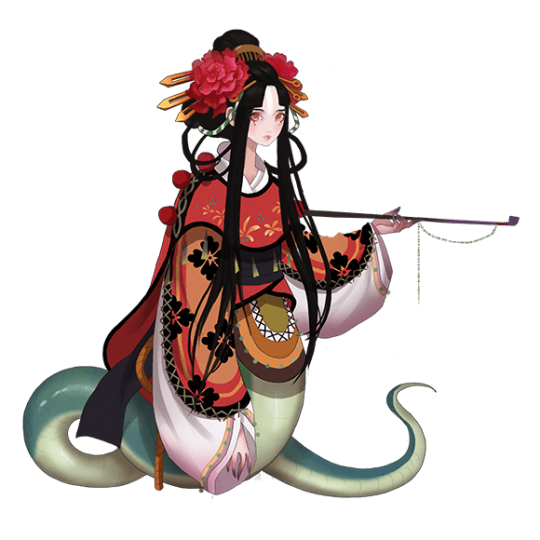
2 notes
·
View notes
Text
Kodama
Kodama are spirits that inhabit trees, their appearance seems to that of a normal looking tree, but, if someone attempts to cut down the tree a Kodama possesses, this person will be cursed, in some Japanese folklore, if an old tree that a Kodama is possessing is cut, blood comes forth from them.
Although, the Kodama can also take the appearance of other living things or inanimate objects if it so wishes and they temporarily leave the tree they are inhabiting, it has been known to take the form of: atmospheric ghost lights, beasts, and humans. There is a story of a Kodama taking on the appearance of a human just to be with the human they fell in love with.

In modern days, if you spot a tree with a shimenawa rope around it, it means that tree has a Kodama residing within it, this is to show what tree NOT to cut down, less you be cursed.
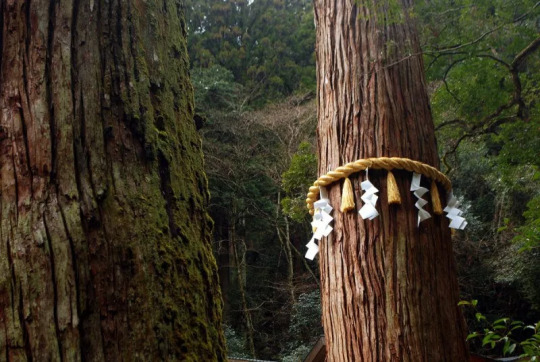
In the film Princess Mononoke, Kodama are presented as small, white humanoid creatures with the facial features of eyes and mouth and some of them possessing a nose.

There is also a character called Sakuya in the videogame Okami, whom is influenced by a Kodama, she appears at the beginning of the game, bringing the character you play as (Amaterasu) back to life, throughout the game after this, her main role is to keep Amaterasu going with words of faith and encouragement.

0 notes
Text
Amazake-Babaa
An Amazake-Babaa is a a form of yokai that is depicted as an old woman asking for alcohol. More specifically, the Amazake-Babaa knocks on somebody’s door late at night, asking for amazake (low alcohol or non-alcoholic drink) in a child-like voice, but, any victim who answers the door, will fall ill from a disease the Amazake-Babaa brings.

To prevent the Amazake-Babaa from knocking on their door, people used to put a Cedar leaf in the doorway of their home. The Amazake-Babaa is also known as the Goddess of Disease, specifically, smallpox, this is because during smallpox outbreaks, there was a large increase in Amazake-Babaa sightings in major urban areas like Osaka and Kyoto.

But since the eradication of smallpox, the rumours of the Amazake-Babaa spreading disease has changed to her spreading the common cold. Nowadays, there are statues of the Amazake-Babaa found in the cities of Japan that are visited by mothers that bring offerings of amazake and sake to the statues so that their children do not become sick.
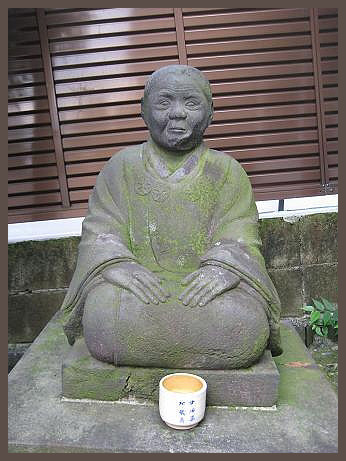
0 notes
Text
Baku
Baku’s are Japanese spirits that devour both dreams and nightmares. Their body is created out of the spare pieces of animals that the Gods had left behind once they had created all animals on earth.
It’s appearance is often depicted to be a creature with: an Elephant trunk, Tiger paws, Rhinoceros eyes, and an Ox’s tail. Legend says that if you have a nightmare, you can wake up and call out for a Baku.

But, you are warned to call out to them sparingly. This is because if the Baku is still hungry after devouring one nightmare, he will devour their hopes and desires as well, leaving the victim to live an empty life.
The Baku can also be summoned for protection from nightmares prior to falling asleep at night. It’s still common today for children in Japan to keep a Baku Talisman at their bedside.
The Baku is used in the media a lot, but they aren’t always blatantly called Baku as much as they’re called “Dream Stealers”, there are also western objects that are similar to the Baku.

There is a vocaloid song called “Dream-Eating Monochrome Baku”. The summary of the song is that the Baku in the story has taken a handsome human form, and is happy to oblige in devouring the nightmares of an unsuspecting woman asking of his services. The first time it occurred, the woman made a promise with the Baku via a pinkie promise, the second, the woman made a promise through a kiss with the Baku, the third, the Baku finally devoured all of the woman’s hopes and desires, leaving her feeling empty inside, with him saying “Didn’t you choose this for yourself?”, making the woman realise that she did this to herself.
https://www.youtube.com/watch?v=SmOeqLHwn5g
0 notes
Text
Kitsune and Nogitsune
Kitsune is the Japanese word for Fox. Kitsune are believed to be omniscient beings that have a long life and possess magical powers. Physically, Kitsune are often noted for having nine tails. According to some folklore, Kitsune start to gain additional tails after they are 100 years old, the most common number of tails that appear in folklore tend to be: one, five, seven and nine.
Kitsune were often seen as “witch animals”, especially during the superstitious Edo period (1603–1867) and weren’t trusted at all unlike in the present day, where they are now considered more to be associated with good luck than bad luck.
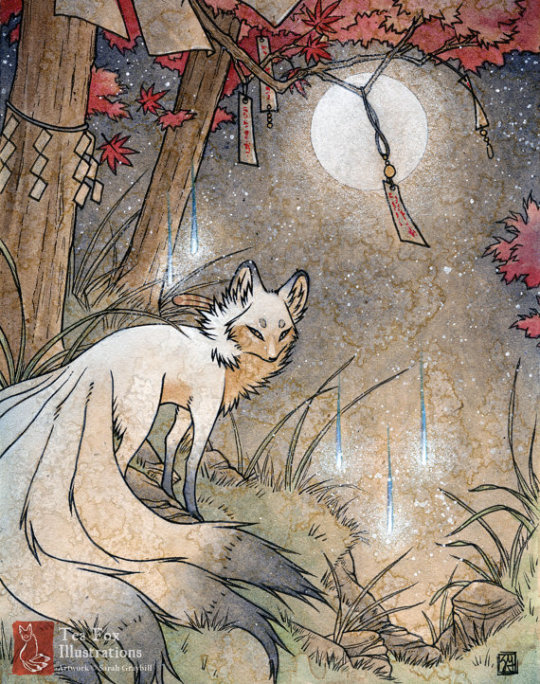
The Kitsune or it’s possessed victim in folklore may include round or onion-shaped balls known as hoshi-no-tama. Stories have described these to be glowing with kitsunebi and are sometimes portrayed as jewels or a pearl. When a kitsune is not possessing a human or in some human form, they carry their hoshi-no-tama either in their mouth or on their tail. A belief of the Kitsune is that when the Kitsune changes shape, the hoshi-no-tama possesses a portion of it’s magical power.
Another belief is that the hoshi-no-tama actually possesses the Kitsune’s soul and they would die if separated from the ball too long. Anyone who obtains a Kitsune’s hoshi-no-tama may be able to extract a promise from the Kitsune to help the person in exchange for the return of their hoshi-no-tama, proving the Kitsune to be loyal and honourable to keep their promise.
The Kitsune in Japanese folklore are commonly portrayed as lovers, often the stories portray young human males falling in love with and marrying a Kitsune disguised as a human woman that proves to be a devoted wife. But when the husband discovers the Kitsune’s true nature, the Kitsune is forced to leave their husband.

Nogitsune are often just called Kitsune, but the Nogitsune are the type of Kitsune that are depicted as tricksters and are normally the type of Kitsune to possess human women. Nogitsune are viewed as malicious spirits and they are very aggressive, they are not above murdering humans as they feed on chaos, strife and pain.

Examples of Kitsune and Nogitsune are: Volpina from Miraculous Ladybug, Shippou from InuYasha, the Nine-Tailed Fox from Naruto, Ninetales and Vulpix from Pokemo, etc.
Vulpix and Ninetales are Pokémon that blatantly reference the Kitsune from Japanese mythology. Vulpix is what evolves into Ninetales, the Vulpix is a fox-type Pokémon that has 6 tails and has fire abilities. The Ninetales is the evolved version of Vulpix and as it’s name entitles, it is a fox-type Pokémon that has nine tails and also has fire abilities.

In Naruto, the demon sealed within the main protagonist, Naruto Uzumaki, is a giant, evil, nine-tailed fox or Kitsune.
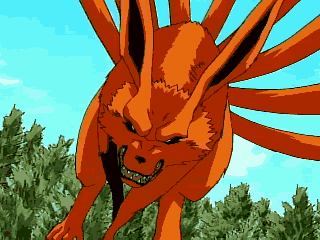
InuYasha is an anime that is mostly set in the Sengoku period where most of the enemies are all kinds of Yokai. One of the main characters in this anime is called Shippou, who is a Kitsune or fox spirit. Shippou is depicted as more of a Nogitsune when he is first introduced as he steals from two other main characters, Kagome and InuYasha, and he uses the little power he has to trick them and lie to them, being displayed as a manipulative and untrustworthy spirit.

Miraculous: Tales of Ladybug and Cat Noir is a western animation aimed at a younger target audience. One of the antagonists called Volpina, is a fox-themed super villain who is a master of illusions. She seems to be heavily influenced by a Kitsune as she is a cunning trickster that uses illusions and lies to fool others and she also takes on the appearance of an attractive young woman.

0 notes
Text
Jorogumo
The Jorogumo is a Yokai from Japanese folklore that is depicted as a shapeshifting woman-spider. The Jorogumo is often depicted as a beautiful women who does not show her true spider-like form until she has someone trapped in some way, often by her webs.

In the two Edo period writings, Tonoigusa and Taihei Hyakumonogatari, the Jorogumo is depicted to be able to shape shift into a woman.
In Tonoigusa, the Jorogumo disguises herself as a 19-20 year old woman and appears to a young warrior, Bushi, and tries tricking Bushi into embracing her “child”, but Bushi sees through her ploy and knew that she was a yokai, so he strikes her with his sword and she retreats to the attic of her home. The next day, Bushi finds a Jorogumo about 1-2 foot long dead in the attic, along with the numerous bodies of people that the Jorogumo had devoured.
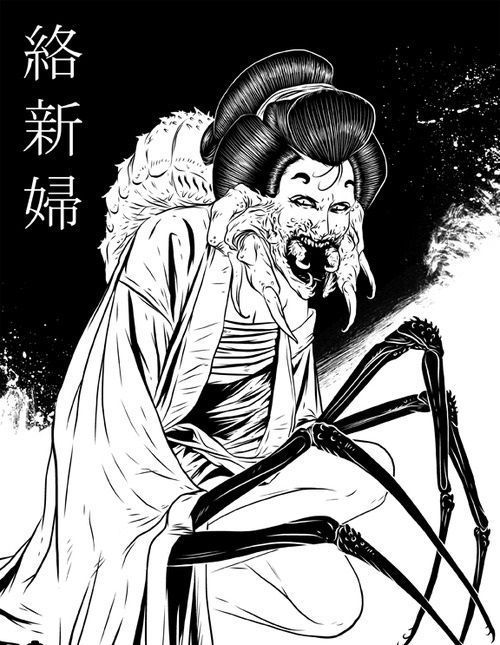
In the Edo writing Taihei Hyakumonogatari, a man called Magoroku was falling asleep on his veranda, this is when he was visited by woman, seemingly in her 50s. She said that her daughter had taken a liking to Magoroku and she invited him back to her estate.
The old woman’s daughter who looked about 16-17 years old, asked him to marry her, but as he was married, he denied her proposal, but the girl persisted. The girl claimed that he had almost killed her mother 2 days prior and yet she still visited him, telling him that her feelings towards him could not amount to nothing.
Magoroku became confused and fled from the estate, once he reached the veranda, Magorku’s wife assured him that he had been sleeping on the veranda the entire time, relieved, Magoroku saw a Joro spider tightly weaving a web in the eaves, and he recalled driving away from his home 2 days ago.
The Jorogumo has appeared in the media many times, a few examples of this is: Okami, Brothers: A Tale of Two Sons, Nioh, Soul Eater, Monster Musume, Rosario + Vampire, Monsters Inc, Coraline, Resident Evil 7, etc.
In Okami, the Jorogumo appears as the first boss battle within the game and she can create webs and appears to possess some of the Orochi’s (eight headed demonic serpent of massive size) power in battle.

Brothers: A Tale of Two Sons is one of the best video games that includes no understandable dialogue, this is because all of the music and actions within the games speak for themselves. You play (as the name entitles) as two brothers going on a quest to save their father from a worsening illness.
Along the way, the older brother convinces the younger brother to save a young girl from some kind of sacrificial ritual. But, this comes back to haunt them later in the game as this girl deceives the boys and leads them into a cave through a small tunnel to kill them.
You end up fighting this girl that reveals her true self to be a Jorogumo, but once you’ve defeated her by pulling out most of her legs, the older brother pulls out the last leg, but in the Jorogumo’s final attempt to kill them, she stabs the older brother in the chest, creating a fatal wound that eventually kills the older brother.

Nioh has several boss fights containing Japanese mythological creatures such as the Nue and the Yuki-Onna, the Jorogumo is no exception. The Jorogumo boss within Nioh is difficult to defeat if you are not prepared as it’s legs is covered in a tough shell like armour, making it highly resistant to damage.

Arachne from Soul Eater isn’t blatantly presented as having the form of a Jorogumo, but she seems to be heavily influenced by a Jorogumo. This is so as her appearance has exaggerated feminine features that are alluring to men, just like the disguised human form of the Jorogumo. Arachne is also a witch revolved around the abilities of a spider, hence the translation of her name from greek meaning “Spider” and her spider-like clothing.
Her abilities are quite useful, her magic attacks, attacks the mind of her victims, attempting to turn them to her side. She also has the ability called “Spider Web” which causes her victims to fall under a spell and be pulled towards madness, she does this by casting her soul out in a a form of a spider’s web, hence the name of the spell.
Another spell she can cast is called “Spider”. This allows her to turn parts of her body into spiders, having these spiders travel to anywhere and acting as extended eyes and ears. The last spell she can cast is “Thread”, with this spell, she can create silk threads that can insert themselves into objects and people, being able to make inanimate objects move and to cause paralysis to people that takes days for the paralysis to dissipate.
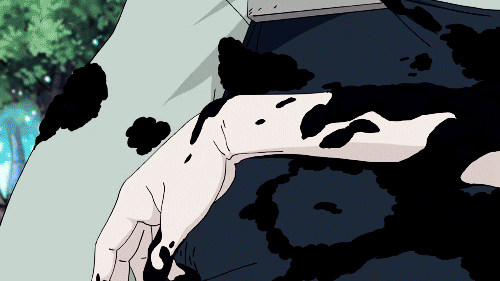
In the anime Monster Musume, Rachnera Arachnera is first introduced as a seemingly evil monster, living up to the name of an Arachne, or more so like a Jorogumo. She is very sadistic and WILL eat people if she wants, but we have not seen her do this as she restrains herself for her host Kimihito.

1 note
·
View note
Text
Yuki-Onna
The Yuki-Onna, AKA the “Snow Woman”, is a yokai that takes the form of a tall, beautiful woman with long black hair and blue lips. Some stories about the Yuki-Onna describes her wearing a white kimono, whereas other stories depict her wearing nothing at all, and her pale white complexion makes her blend in with the snowy weather, only her face and hair standing out from the snow.
As entitled by her name, the Yuki-Onna appears on snowy nights, she is said to be the spirit of a woman who has perished in the snow. In many stories of the Yuki-Onna, she was often portrayed to be an evil spirit, up until the 18th century.

Within some of the stories of the Yuki-Onna, she would prey on weak-willed men and either drain their life force or freeze them through wither sex or a kiss. In other stories, she would appear to travellers trapped in snowstorms and would freeze them to death with her icy breath, or she would manifest with a “child” and when a well-intentioned person takes the child from her to hold, they are frozen in place.

But, there ARE some legends of the Yuki-Onna being merciful, making her seem more like a human than a monster. In Lafcadio Hearn’s version of the Yuki-Onna, she spares the life of a boy because of his beauty and age but makes him promise to never speak of her existence.
However, this boy, later in his life, breaks this promise by telling his wife of her which was the Yuki-Onna who told him to not speak of her. But, even though she reviled him for breaking his promise, she spared him once again out of the concern for their children, but if he were to mistreat their children, she would return, and grant no mercy upon him. And with that, she melted and disappeared, never to be seen again.
The Yuki-Onna is very popular among Japanese mythological beings, giving her many different stories to work from, and the more popular she became, the more she was used in the media. Examples of this are: Nioh, Rosario + Vampire, Urusei Yatsura, InuYasha, Senran Kagura, etc.

In Nioh, the Yuki-Onna is a boss you have to fight within the game, but once you have defeated her, she thanks you and says “Now I can go, and be with my Lord again.” before turning into snow and fading away.
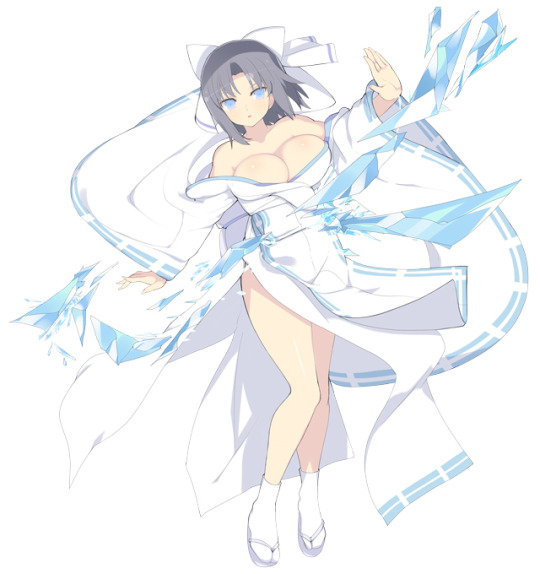
In the Senran Kagura video game series, the character Yumi is heavily influenced by the Yuki-Onna’s powers and appearance. Yumi is a shinobi that utilises ice in her powers. Her appearance matches the Yuki-Onna by her kimono and pale complexion.
0 notes
Text
Japanese Mythological Creatures: Research (Part 1)
I went through all the Japanese mythological creatures from A to Z and chose all the ones I felt were the most interesting and wrote down brief descriptions of what the creatures are. Once I had completed that, I narrowed down the results by highlighting the creatures with yellow sharpie that I find to have more interesting stories/folklore to them that I would be able to incorporate within a story.




In conclusion, I will be researching the final 20 chosen creatures into more depth.
0 notes
Text
Goryo
Goryo are Japanese vengeful spirits, mainly from the Aristocratic classes that have been martyred. The name “Goryo” translated from Japanese to English means “Honourable Spirit/Soul”.
The Goryo was mainly recognise during the Heian period in Japan, and the belief was that these vengeful spirits were the spirits of powerful lords who had been wronged, and to carry out their vengeance, they would summon typhoons and earthquakes to destroy crops.

An example of a famous Goryo is the shinto kami, Tenjin. Tenjin was called Sugawara no Michizane before he died. He was regarded as a magnificent poet, scholar and politician, but, he was killed by a rival member of the Fujiwara clan, but in the coming years after his death, disaster struck the city he resided in.

The city was struck by heavy rain and lightning, which ended up killing the adversary Fujiwara who killed him as well as Emperor Daigo’s crown prince in the process, while fires caused by lightning and floods destroyed many residences within the city.
0 notes